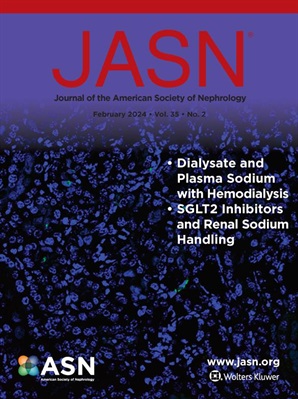达格列净对CKD患者健康相关生活质量的影响。
IF 9.4
1区 医学
Q1 UROLOGY & NEPHROLOGY
引用次数: 0
摘要
背景:钠-葡萄糖共转运蛋白2 (SGLT2)抑制剂达格列净治疗可减缓慢性肾病(CKD)患者肾脏疾病的进展,降低心衰和死亡的风险。关于达格列净对健康相关生活质量(HRQoL)影响的数据有限。方法:慢性肾病、合并或不合并2型糖尿病、肾小球滤过率(eGFR) 25-75 mL/min/1.73m2、尿白蛋白/肌酐比值200- 5000mg /g的成人随机分为达格列净组(10mg /d)和安慰剂组。我们在基线和12、24和36个月时使用肾脏疾病生活质量(KDQOL-36)问卷评估HRQoL。在这个预先指定的分析中,我们确定了达格列净与安慰剂的总体效果。结果4032/4304例(94%)随机受试者(平均年龄62(12)岁,女性32%)基线时有KDQOL-36信息。身体健康综合指数(PHC)的平均得分;心理健康综合(MHC);肾脏疾病的症状、影响和负担在基线时在随机分组之间相似。在中位随访时间为2.3年(四分位数间距:1.9,2.6)期间,随机分配到达格列净组的参与者因PHC (0.71 [95%CI: 0.30, 1.31])、MHC (0.62 [95%CI: 0.14, 1.11])、肾脏疾病症状(1.33 [95%CI: 0.57, 2.10])、肾脏疾病影响(1.34 [95%CI: 0.43, 2.26])和肾脏疾病负担(1.46 [95%CI: 0.30, 2.62])的平均得分显著较高。随机分配到达格列净组的受试者出现有临床意义(≥10个单位)PHC下降的可能性明显低于安慰剂组(风险比[HR] 0.84 (95% CI: 0.74, 0.96)。MHC下降≥10个单位、肾脏疾病症状、影响和负担的相应hr分别为0.95 (95% CI: 0.85, 1.07)、0.84 (95% CI: 0.75, 0.94)、0.84 (95% CI: 0.72, 0.97)和0.93 (95% CI: 0.84, 1.02)。结论:在伴有或不伴有2型糖尿病的CKD参与者中,达格列净治疗减缓了身体健康的下降,减轻了症状的恶化,并减轻了肾脏疾病的影响。本文章由计算机程序翻译,如有差异,请以英文原文为准。
Effects of Dapagliflozin on Health-Related Quality of Life in Patients with CKD.
BACKGROUND
Treatment with the sodium-glucose cotransporter 2 (SGLT2) inhibitor, dapagliflozin, attenuates progression of kidney disease and reduces the risks of heart failure and death in patients with chronic kidney disease (CKD). Data on the effects of dapagliflozin on health-related quality of life (HRQoL) are limited.
METHODS
Adults with CKD, with and without type 2 diabetes, with estimated glomerular filtration rate (eGFR) 25-75 mL/min/1.73m2 and urinary albumin-to-creatinine ratio 200-5000 mg/g were randomized to dapagliflozin (10 mg/day) or placebo. We assessed HRQoL using the Kidney Disease Quality of Life (KDQOL-36) questionnaire at baseline and at 12, 24, and 36 months. In this prespecified analysis, we determined the overall effects of dapagliflozin versus placebo.
RESULTS
A total of 4032/4304 (94%) randomized participants (mean age 62(12) years, 32% female) had information on KDQOL-36 at baseline. Mean scores on the physical health composite (PHC); mental health composite (MHC); and kidney disease symptoms, effects, and burden were similar between randomized groups at baseline. During a median follow-up of 2.3 (Interquartile range: 1.9, 2.6) years, mean scores were significantly higher in participants randomized to dapagliflozin for PHC (0.71 [95% CI: 0.30, 1.31]), MHC (0.62 [95%CI: 0.14, 1.11]) kidney disease symptoms (1.33 [95% CI: 0.57, 2.10]), kidney disease effects (1.34 [95% CI: 0.43, 2.26]) and kidney disease burden (1.46 [95%CI: 0.30, 2.62]). Participants randomized to dapagliflozin were significantly less likely to experience a clinically meaningful (≥10 units) decline in PHC relative to placebo (hazard ratio [HR] 0.84 (95% CI: 0.74, 0.96). Corresponding HRs for ≥10-unit decline in MHC, and kidney disease symptoms, effects, and burden were 0.95 (95% CI: 0.85, 1.07), 0.84 (95% CI: 0.75, 0.94), and 0.84 (95% CI: 0.72, 0.97) and 0.93 (95% CI: 0.84, 1.02), respectively.
CONCLUSIONS
In participants with CKD with and without type 2 diabetes, treatment with dapagliflozin slowed the decline in physical health, reduced worsening of symptoms, and lessened the effect of kidney disease.
求助全文
通过发布文献求助,成功后即可免费获取论文全文。
去求助
来源期刊
CiteScore
22.40
自引率
2.90%
发文量
492
审稿时长
3-8 weeks
期刊介绍:
The Journal of the American Society of Nephrology (JASN) stands as the preeminent kidney journal globally, offering an exceptional synthesis of cutting-edge basic research, clinical epidemiology, meta-analysis, and relevant editorial content. Representing a comprehensive resource, JASN encompasses clinical research, editorials distilling key findings, perspectives, and timely reviews.
Editorials are skillfully crafted to elucidate the essential insights of the parent article, while JASN actively encourages the submission of Letters to the Editor discussing recently published articles. The reviews featured in JASN are consistently erudite and comprehensive, providing thorough coverage of respective fields. Since its inception in July 1990, JASN has been a monthly publication.
JASN publishes original research reports and editorial content across a spectrum of basic and clinical science relevant to the broad discipline of nephrology. Topics covered include renal cell biology, developmental biology of the kidney, genetics of kidney disease, cell and transport physiology, hemodynamics and vascular regulation, mechanisms of blood pressure regulation, renal immunology, kidney pathology, pathophysiology of kidney diseases, nephrolithiasis, clinical nephrology (including dialysis and transplantation), and hypertension. Furthermore, articles addressing healthcare policy and care delivery issues relevant to nephrology are warmly welcomed.

 求助内容:
求助内容: 应助结果提醒方式:
应助结果提醒方式:


